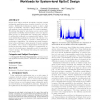Free Online Productivity Tools
i2Speak
i2Symbol
i2OCR
iTex2Img
iWeb2Print
iWeb2Shot
i2Type
iPdf2Split
iPdf2Merge
i2Bopomofo
i2Arabic
i2Style
i2Image
i2PDF
iLatex2Rtf
Sci2ools
DAC
2005
ACM
2005
ACM
Approximate VCCs: a new characterization of multimedia workloads for system-level MpSoC design
System-level design methods specifically targeted towards multimedia applications have recently received a lot of attention. Multimedia workloads are known to have a high degree of variability. Therefore, designs based on a worstcase analysis of such workloads tend of be overly pessimistic. We address this issue by introducing a new concept called approximate variability characterization curves (or Approximate VCCs), to characterize the "average-case" behavior of multimedia workloads in a parameterized fashion. Since most multimedia applications only have soft real-time constraints, it is often possible to tolerate a small amount of performance degradation. By allowing such small degradations in the performance, large amounts of resource savings are possible. The concept of Approximate VCCs that we present in this paper allows a designer to quantitatively account for the performance degradation and the associated resource savings. We illustrate this using two typical system ...
Approximate Variability Characterization | DAC 2005 | Design Automation | Design Keywords Multimedia | Multimedia Workloads |
| Added | 13 Nov 2009 |
| Updated | 13 Nov 2009 |
| Type | Conference |
| Year | 2005 |
| Where | DAC |
| Authors | Yanhong Liu, Samarjit Chakraborty, Wei Tsang Ooi |
Comments (0)

